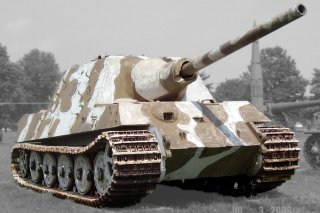This Nazi Monster Supertank Was a Killer (When It Actually Worked)
The Jagdtigers were nigh-unstoppable when working. However, for every one lost to enemy action, six were lost to mechanical failure.
Ernst’s remaining four Jagdtigers were reinforced by a platoon each of Panzer IV medium tanks, Stug IV assault guns and Sd.Kfz. 7/2 self-propelled flak guns. On April 11 these deployed to a ridge overlooking the road to Langschede. When an American column from the Eighth Division came rolling through the valley below them, Ernst’s battlegroup unleashed a hail of armor piercing shells, knocking out eleven Shermans and forty more vehicles. The American column fell back in panic—and called in air support. Three waves of P-47s swooped down lew up a Jagdtiger and a flak-track—but flak shells and machine guns caused two of the jug-shaped fighters to crash in flames.
An important caveat is that the German claims were likely in excess of actual Allied losses, as tankers on all sides tended to overclaim. However, this battlefield appears to be described by British officer George Forty in his book German Tanks of World War II:
“I remember vividly coming across what seemed to be an entire regiment of Sherman tanks which had been completely annihilated. There were Shermans lying in heaps everywhere one looked, turrets blown off, hulls ripped apart, most had clearly been brewed up. . . . They had been advancing with the grain of the country and had clearly been taken by surprise from a flank. The follow-up echelon had then turned right-handed towards their tormentor, but had found little cover along their new line of advance. The author of all this carnage was one single Jagdtiger, whose immense bulk still occupied a perfect fire position in a farmyard at the top of a commanding hill feature.”
So Jagdtigers could live up to their intimidating reputation on the rare occasions they were able to deploy into good ambush positions miles away from enemy forces, allowing them to take full advantage of their oversized guns and minimize exposure to flank attacks. But the reichsmarks and man-hours necessary to build a single Jagdtiger could have produced an entire platoon Panthers or Jagdpanthers, which were nearly as effective in most circumstances and less likely to break down. A malfunctioning, fuel-devouring super tank hardly benefited a desperate Nazi Germany.
Between April 12 and 15, Ernst’s Jagdtigers continued to disrupt poorly coordinated U.S. advances with long-range fires, knocking out at least four more Shermans—while being forced to scuttle six more broken-down Jagdtigers. However, as German positions collapsed, Captain Ernst was left the ranking officer in the region.
Wishing to spare refugee-packed Iserlohn from destruction, Ernst met with Lt. Col. Robert Kriz of the U.S. Ninety-Ninth Infantry Division on April 16 to arrange the surrender of German forces in the pocket.
It’s a fitting irony that the best recorded footage of the humongous tank destroyers was filmed as Ernst’s last three Jagdtigers rolled in an orderly formation into Iserlohn’s Schiller Square before assembled American troops and local civilians. This dignified act of surrender was arguably the finest moment of a beastly weapon of war.
Sébastien Roblin holds a master’s degree in conflict resolution from Georgetown University and served as a university instructor for the Peace Corps in China. He has also worked in education, editing, and refugee resettlement in France and the United States. He currently writes on security and military history for War Is Boring.
This article first appeared in 2019 and is being reprinted due to reader interest.
Image: Wikimedia Commons.

